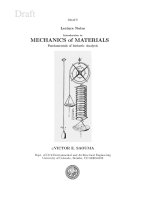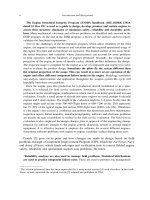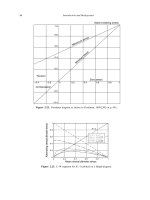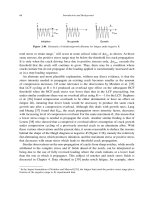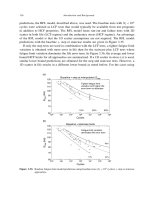Mechanics.Of.Materials.Saouma Episode 7 docx
Bạn đang xem bản rút gọn của tài liệu. Xem và tải ngay bản đầy đủ của tài liệu tại đây (240.32 KB, 20 trang )
Draft
7.2 Stress-Strain Relations in Generalized Elasticity 7
29 Yet we have the elementary relations in terms engineering constants E Young’s modulus and ν
Poisson’s ratio
ε
11
=
σ
E
(7.30-a)
ν = −
ε
22
ε
11
= −
ε
33
ε
11
(7.30-b)
then it follows that
1
E
=
λ + µ
µ(3λ +2µ)
; ν =
λ
2(λ + µ)
(7.31)
λ =
νE
(1 + ν)(1 − 2ν)
; µ = G =
E
2(1 + ν)
(7.32)
30 Similarly in the case of pure shear in the x
1
x
3
and x
2
x
3
planes, we have
σ
21
= σ
12
= τ all other σ
ij
= 0 (7.33-a)
2ε
12
=
τ
G
(7.33-b)
and the µ is equal to the shear modulus G.
31 Hooke’s law for isotropic material in terms of engineering constants becomes
σ
ij
=
E
1+ν
ε
ij
+
ν
1 − 2ν
δ
ij
ε
kk
or σ =
E
1+ν
ε +
ν
1 − 2ν
I
ε
(7.34)
ε
ij
=
1+ν
E
σ
ij
−
ν
E
δ
ij
σ
kk
or ε =
1+ν
E
σ −
ν
E
I
σ
(7.35)
32 When the strain equation is expanded in 3D cartesian coordinates it would yield:
ε
xx
ε
yy
ε
zz
γ
xy
(2ε
xy
)
γ
yz
(2ε
yz
)
γ
zx
(2ε
zx
)
=
1
E
1 −ν −ν 000
−ν 1 −ν 000
−ν −ν 10 0 0
0001+ν 00
000 01+ν 0
000 0 01+ν
σ
xx
σ
yy
σ
zz
τ
xy
τ
yz
τ
zx
(7.36)
33 If we invert this equation, we obtain
σ
xx
σ
yy
σ
zz
τ
xy
τ
yz
τ
zx
=
E
(1+ν)(1−2ν)
1 − νν ν
ν 1 −νν
νν1 − ν
0
0 G
100
010
001
ε
xx
ε
yy
ε
zz
γ
xy
(2ε
xy
)
γ
yz
(2ε
yz
)
γ
zx
(2ε
zx
)
(7.37)
7.2.5.1.1.2 Bulk’s Modulus; Volumetric and Deviatoric Strains
34 We can express the trace of the stress I
σ
in terms of the volumetric strain I
ε
From Eq. 7.27
σ
ii
= λδ
ii
ε
kk
+2µε
ii
=(3λ +2µ)ε
ii
≡ 3Kε
ii
(7.38)
Victor Saouma Mechanics of Materials II
Draft
8 CONSTITUTIVE EQUATIONS; Part I Engineering Approach
or
K = λ +
2
3
µ
(7.39)
35 We can provide a complement to the volumetric part of the constitutive equations by substracting
the trace of the stress from the stress tensor, hence we define the deviatoric stress and strains as as
σ
≡ σ −
1
3
(tr σ)I (7.40)
ε
≡ ε −
1
3
(tr ε)I (7.41)
and the corresponding constitutive relation will be
σ = KeI +2µε
(7.42)
ε =
p
3K
I +
1
2µ
σ
(7.43)
where p ≡
1
3
tr (σ) is the pressure, and σ
= σ −pI is the stress deviator.
7.2.5.1.1.3 †Restriction Imposed on the Isotropic Elastic Moduli
36 We can rewrite Eq. 18.29 as
dW = T
ij
dE
ij
(7.44)
but since dW is a scalar invariant (energy), it can be expressed in terms of volumetric (hydrostatic) and
deviatoric components as
dW = −pde + σ
ij
dE
ij
(7.45)
substituting p = −Ke and σ
ij
=2GE
ij
, and integrating, we obtain the following expression for the
isotropic strain energy
W =
1
2
Ke
2
+ GE
ij
E
ij
(7.46)
and since positive work is required to cause any deformation W>0thus
λ +
2
3
G ≡ K>0 (7.47-a)
G>0 (7.47-b)
ruling out K = G = 0, we are left with
E>0; −1 <ν<
1
2
(7.48)
37 The isotropic strain energy function can be alternatively expressed as
W =
1
2
λe
2
+ GE
ij
E
ij
(7.49)
38 From Table 7.1, we observe that ν =
1
2
implies G =
E
3
,and
1
K
= 0 or elastic incompressibility.
39 The elastic properties of selected materials is shown in Table 7.2.
Victor Saouma Mechanics of Materials II
Draft
7.2 Stress-Strain Relations in Generalized Elasticity 9
λ, µ E, ν µ, ν E, µ K, ν
λ λ
νE
(1+ν)(1−2ν)
2µν
1−2ν
µ(E−2µ)
3µ−E
3Kν
1+ν
µ µ
E
2(1+ν)
µµ
3K(1−2ν)
2(1+ν)
K λ +
2
3
µ
E
3(1−2ν)
2µ(1+ν)
3(1−2ν)
µE
3(3µ−E)
K
E
µ(3λ+2µ)
λ+µ
E 2µ(1 + ν) E 3K(1 − 2ν)
ν
λ
2(λ+µ)
νν
E
2µ
− 1 ν
Table 7.1: Conversion of Constants for an Isotropic Elastic Material
Material E (MPa) ν
A316 Stainless Steel 196,000 0.3
A5 Aluminum 68,000 0.33
Bronze 61,000 0.34
Plexiglass 2,900 0.4
Rubber 2 →0.5
Concrete 60,000 0.2
Granite 60,000 0.27
Table 7.2: Elastic Properties of Selected Materials at 20
0c
7.2.5.1.2 †Transversly Isotropic Case
40 For transversely isotropic, we can express the stress-strain relation in tems of
ε
xx
= a
11
σ
xx
+ a
12
σ
yy
+ a
13
σ
zz
ε
yy
= a
12
σ
xx
+ a
11
σ
yy
+ a
13
σ
zz
ε
zz
= a
13
(σ
xx
+ σ
yy
)+a
33
σ
zz
γ
xy
=2(a
11
− a
12
)τ
xy
γ
yz
= a
44
τ
xy
γ
xz
= a
44
τ
xz
(7.50)
and
a
11
=
1
E
; a
12
= −
ν
E
; a
13
= −
ν
E
; a
33
= −
1
E
; a
44
= −
1
µ
(7.51)
where E is the Young’s modulus in the plane of isotropy and E
the one in the plane normal to it. ν
corresponds to the transverse contraction in the plane of isotropy when tension is applied in the plane;
ν
corresponding to the transverse contraction in the plane of isotropy when tension is applied normal
to the plane; µ
corresponding to the shear moduli for the plane of isotropy and any plane normal to it,
and µ is shear moduli for the plane of isotropy.
7.2.5.2 Special 2D Cases
41 Often times one can make simplifying assumptions to reduce a 3D problem into a 2D one.
7.2.5.2.1 Plane Strain
42 For problems involving a long body in the z direction with no variation in load or geometry, then
Victor Saouma Mechanics of Materials II
Draft
10 CONSTITUTIVE EQUATIONS; Part I Engineering Approach
ε
zz
= γ
yz
= γ
xz
= τ
xz
= τ
yz
= 0. Thus, replacing into Eq. 7.37 we obtain
σ
xx
σ
yy
σ
zz
τ
xy
=
E
(1 + ν)(1 − 2ν)
(1 − ν) ν 0
ν (1 − ν)0
νν0
00
1−2ν
2
ε
xx
ε
yy
γ
xy
(7.52)
7.2.5.2.2 Axisymmetry
43 In solids of revolution, we can use a polar coordinate sytem and
ε
rr
=
∂u
∂r
(7.53-a)
ε
θθ
=
u
r
(7.53-b)
ε
zz
=
∂w
∂z
(7.53-c)
ε
rz
=
∂u
∂z
+
∂w
∂r
(7.53-d)
44 The constitutive relation is again analogous to 3D/plane strain
σ
rr
σ
zz
σ
θθ
τ
rz
=
E
(1 + ν)(1 − 2ν)
1 − νν ν 0
ν 1 −νν 0
νν1 − ν 0
νν1 − ν 0
000
1−2ν
2
ε
rr
ε
zz
ε
θθ
γ
rz
(7.54)
7.2.5.2.3 Plane Stress
45 If the longitudinal dimension in z direction is much smaller than in the x and y directions, then
τ
yz
= τ
xz
= σ
zz
= γ
xz
= γ
yz
= 0 throughout the thickness. Again, substituting into Eq. 7.37 we
obtain:
σ
xx
σ
yy
τ
xy
=
1
1 − ν
2
1 ν 0
ν 10
00
1−ν
2
ε
xx
ε
yy
γ
xy
(7.55-a)
ε
zz
= −
1
1 − ν
ν(ε
xx
+ ε
yy
) (7.55-b)
7.3 †Linear Thermoelasticity
46 If thermal effects are accounted for, the components of the linear strain tensor E
ij
may be considered
as the sum of
E
ij
= E
(T )
ij
+ E
(Θ)
ij
(7.56)
where E
(T )
ij
is the contribution from the stress field, and E
(Θ)
ij
the contribution from the temperature
field.
47 When a body is subjected to a temperature change Θ − Θ
0
with respect to the reference state
temperature, the strain componenet of an elementary volume of an unconstrained isotropic body are
given by
E
(Θ)
ij
= α(Θ − Θ
0
)δ
ij
(7.57)
Victor Saouma Mechanics of Materials II
Draft
7.4 Fourrier Law 11
where α is the linear coefficient of thermal expansion.
48 Inserting the preceding two equation into Hooke’s law (Eq. 7.28) yields
E
ij
=
1
2µ
T
ij
−
λ
3λ +2µ
δ
ij
T
kk
+ α(Θ − Θ
0
)δ
ij
(7.58)
which is known as Duhamel-Neumann relations.
49 If we invert this equation, we obtain the thermoelastic constitutive equation:
T
ij
= λδ
ij
E
kk
+2µE
ij
− (3λ +2µ)αδ
ij
(Θ − Θ
0
)
(7.59)
50 Alternatively, if we were to consider the derivation of the Green-elastic hyperelastic equations, (Sect.
18.5.1), we required the constants c
1
to c
6
in Eq. 18.31 to be zero in order that the stress vanish in the
unstrained state. If we accounted for the temperature change Θ −Θ
0
with respect to the reference state
temperature, we would have c
k
= −β
k
(Θ − Θ
0
)fork = 1 to 6 and would have to add like terms to Eq.
18.31, leading to
T
ij
= −β
ij
(Θ − Θ
0
)+c
ijrs
E
rs
(7.60)
for linear theory, we suppose that β
ij
is independent from the strain and c
ijrs
independent of temperature
change with respect to the natural state. Finally, for isotropic cases we obtain
T
ij
= λE
kk
δ
ij
+2µE
ij
− β
ij
(Θ − Θ
0
)δ
ij
(7.61)
which is identical to Eq. 7.59 with β =
Eα
1−2ν
. Hence
T
Θ
ij
=
Eα
1 − 2ν
(7.62)
51 In terms of deviatoric stresses and strains we have
T
ij
=2µE
ij
and E
ij
=
T
ij
2µ
(7.63)
and in terms of volumetric stress/strain:
p = −Ke + β(Θ −Θ
0
)ande =
p
K
+3α(Θ − Θ
0
)
(7.64)
7.4 Fourrier Law
52 Consider a solid through which there is a flow q of heat (or some other quantity such as mass, chemical,
etc )
53 The rate of transfer per unit area is q
54 The direction of flow is in the direction of maximum “potential” (temperature in this case, but could
be, piezometric head, or ion concentration) decreases (Fourrier, Darcy, Fick ).
q =
q
x
q
y
q
z
= −D
∂φ
∂x
∂φ
∂y
∂φ
∂z
= −D∇φ (7.65)
Victor Saouma Mechanics of Materials II
Draft
12 CONSTITUTIVE EQUATIONS; Part I Engineering Approach
D is a three by three (symmetric) constitutive/conductivity matrix
The conductivity can be either
Isotropic
D = k
100
010
001
(7.66)
Anisotropic
D =
k
xx
k
xy
k
xz
k
yx
k
yy
k
yz
k
zx
k
zy
k
zz
(7.67)
Orthotropic
D =
k
xx
00
0 k
yy
0
00k
zz
(7.68)
Note that for flow through porous media, Darcy’s equation is only valid for laminar flow.
7.5 Updated Balance of Equations and Unknowns
55 In light of the new equations introduced in this chapter, it would be appropriate to revisit our balance
of equations and unknowns.
Coupled Uncoupled
dρ
dt
+ ρ
∂v
i
∂x
i
=0 Continuity Equation 1 1
∂T
ij
∂x
j
+ ρb
i
= ρ
dv
i
dt
Equation of motion 3 3
ρ
du
dt
= T
ij
D
ij
+ ρr −
∂q
j
∂x
j
Energy equation 1
T = λI
E
+2µE Hooke’s Law 6 6
q = −D∇φ Heat Equation (Fourrier) 3
Θ=Θ(s, ν); τ
j
= τ
j
(s, ν) Equations of state 2
Total number of equations 16 10
and we repeat our list of unknowns
Coupled Uncoupled
Density ρ 1 1
Velocity (or displacement) v
i
(u
i
) 3 3
Stress components T
ij
6 6
Heat flux components q
i
3 -
Specific internal energy u 1 -
Entropy density s 1 -
Absolute temperature Θ 1 -
Total number of unknowns 16 10
and in addition the Clausius-Duhem inequality
ds
dt
≥
r
Θ
−
1
ρ
div
q
Θ
which governs entropy production
must hold.
56 Hence we now have as many equations as unknowns and are (almost) ready to pose and solve problems
in continuum mechanics.
Victor Saouma Mechanics of Materials II
Draft
Part II
ELASTICITY/SOLID
MECHANICS
Draft
Draft
Chapter 8
BOUNDARY VALUE PROBLEMS
in ELASTICITY
8.1 Preliminary Considerations
1 All problems in elasticity require three basic components:
3 Equations of Motion (Equilibrium): i.e. Equations relating the applied tractions and body forces
to the stresses (3)
∂T
ij
∂X
j
+ ρb
i
= ρ
∂
2
u
i
∂t
2
(8.1)
6 Stress-Strain relations: (Hooke’s Law)
T = λI
E
+2µE (8.2)
6 Geometric (kinematic) equations: i.e. Equations of geometry of deformation relating displace-
ment to strain (6)
E
∗
=
1
2
(u∇
x
+ ∇
x
u) (8.3)
2 Those 15 equations are written in terms of 15 unknowns: 3 displacement u
i
, 6 stress components T
ij
,
and 6 strain components E
ij
.
3 In addition to these equations which describe what is happening inside the body, we must describe
what is happening on the surface or boundary of the body, just like for the solution of a differential
equation. These extra conditions are called boundary conditions.
8.2 Boundary Conditions
4 In describing the boundary conditions (B.C.), we must note that:
1. Either we know the displacement but not the traction, or we know the traction and not the
corresponding displacement. We can never know both a priori.
2. Not all boundary conditions specifications are acceptable. For example we can not apply tractions
to the entire surface of the body. Unless those tractions are specially prescribed, they may not
necessarily satisfy equilibrium.
Draft
2 BOUNDARY VALUE PROBLEMS in ELASTICITY
5 Properly specified boundary conditions result in well-posed boundary value problems, while improp-
erly specified boundary conditions will result in ill-posed boundary value problem. Only the former
can be solved.
6 Thus we have two types of boundary conditions in terms of known quantitites, Fig. 8.1:
Ω
Γ
Τ
u
t
Figure 8.1: Boundary Conditions in Elasticity Problems
Displacement boundary conditions along Γ
u
with the three components of u
i
prescribed on the
boundary. The displacement is decomposed into its cartesian (or curvilinear) components, i.e.
u
x
,u
y
Traction boundary conditions along Γ
t
with the three traction components t
i
= n
j
T
ij
prescribed
at a boundary where the unit normal is n. The traction is decomposed into its normal and shear(s)
components, i.e t
n
,t
s
.
Mixed boundary conditions where displacement boundary conditions are prescribed on a part of
the bounding surface, while traction boundary conditions are prescribed on the remainder.
We note that at some points, traction may be specified in one direction, and displacement at another.
Displacement and tractions can never be specified at the same point in the same direction.
7 Various terms have been associated with those boundary conditions in the litterature, those are su-
umarized in Table 8.1.
u,Γ
u
t,Γ
t
Dirichlet Neuman
Field Variable Derivative(s) of Field Variable
Essential Non-essential
Forced Natural
Geometric Static
Table 8.1: Boundary Conditions in Elasticity
8 Often time we take advantage of symmetry not only to simplify the problem, but also to properly
define the appropriate boundary conditions, Fig. 8.2.
Victor Saouma Mechanics of Materials II
Draft
8.3 Boundary Value Problem Formulation 3
x
y
?
AB
C
D
E
σ
Note: Unknown tractions=Reactions
t
ny
u
u
Γ
x
u
CD
BC
AB ? 0 ?
DE
EA
t
s
Γ
t
0
?
σ
?
?
?
?
0
?
?
0
0
0
0
0
0
Figure 8.2: Boundary Conditions in Elasticity Problems
8.3 Boundary Value Problem Formulation
9 Hence, the boundary value formulation is suumarized by
∂T
ij
∂X
j
+ ρb
i
= ρ
∂
2
u
i
∂t
2
in Ω (8.4)
E
∗
=
1
2
(u∇
x
+ ∇
x
u) (8.5)
T = λI
E
+2µE in Ω (8.6)
u =
u in Γ
u
(8.7)
t =
t in Γ
t
(8.8)
and is illustrated by Fig. 8.3. This is now a well posed problem.
8.4 †Compact Forms
10 Solving a boundary value problem with 15 unknowns through 15 equations is a formidable task.
Hence, there are numerous methods to reformulate the problem in terms of fewer unknows.
8.4.1 Navier-Cauchy Equations
11 One such approach is to substitute the displacement-strain relation into Hooke’s law (resulting in
stresses in terms of the gradient of the displacement), and the resulting equation into the equation of
motion to obtain three second-order partial differential equations for the three displacement components
known as Navier’s Equation
(λ + µ)
∂
2
u
k
∂X
i
∂X
k
+ µ
∂
2
u
i
∂X
k
∂X
k
+ ρb
i
= ρ
∂
2
u
i
∂t
2
(8.9)
or
(λ + µ)∇(∇·u)+µ∇
2
u + ρb = ρ
∂
2
u
∂t
2
(8.10)
(8.11)
Victor Saouma Mechanics of Materials II
Draft
4 BOUNDARY VALUE PROBLEMS in ELASTICITY
Natural B.C.
t
i
:Γ
t
Stresses
T
ij
Equilibrium
∂T
ij
∂x
j
+ ρb
i
= ρ
dv
i
dt
Body Forces
b
i
Constitutive Rel.
T = λI
E
+2µE
Strain
E
ij
Kinematics
E
∗
=
1
2
(u∇
x
+ ∇
x
u)
Displacements
u
i
Essential B.C.
u
i
:Γ
u
✻
❄
❄
❄
❄
❄
✲ ✛
Figure 8.3: Fundamental Equations in Solid Mechanics
8.4.2 Beltrami-Mitchell Equations
12 Whereas Navier-Cauchy equation was expressed in terms of the gradient of the displacement, we can
follow a similar approach and write a single equation in term of the gradient of the tractions.
∇
2
T
ij
+
1
1+ν
T
pp,ij
= −
ν
1 − ν
δ
ij
∇·(ρb) − ρ(b
i,j
+ b
j,i
) (8.12)
or
T
ij,pp
+
1
1+ν
T
pp,ij
= −
ν
1 − ν
δ
ij
ρb
p,p
− ρ(b
i,j
+ b
j,i
) (8.13)
8.4.3 Airy Stress Function
Airy stress function, for plane strain problems will be separately covered in Sect. 9.2.
8.4.4 Ellipticity of Elasticity Problems
8.5 †Strain Energy and Extenal Work
13 For the isotropic Hooke’s law, we saw that there always exist a strain energy function W which is
positive-definite, homogeneous quadratic function of the strains such that, Eq. 18.29
T
ij
=
∂W
∂E
ij
(8.14)
hence it follows that
W =
1
2
T
ij
E
ij
(8.15)
Victor Saouma Mechanics of Materials II
Draft
8.6 †Uniqueness of the Elastostatic Stress and Strain Field 5
14 The external work done by a body in equilibrium under body forces b
i
and surface traction t
i
is
equal to
Ω
ρb
i
u
i
dΩ+
Γ
t
i
u
i
dΓ. Substituting t
i
= T
ij
n
j
and applying Gauss theorem, the second term
becomes
Γ
T
ij
n
j
u
i
dΓ=
Ω
(T
ij
u
i
)
,j
dΩ=
Ω
(T
ij,j
u
i
+ T
ij
u
i,j
)dΩ (8.16)
but T
ij
u
i,j
= T
ij
(E
ij
+Ω
ij
)=T
ij
E
ij
and from equilibrium T
ij,j
= −ρb
i
,thus
Ω
ρb
i
u
i
dΩ+
Γ
t
i
u
i
dΓ=
Ω
ρb
i
u
i
dΩ+
Ω
(T
ij
E
ij
− ρb
i
u
i
)dΩ (8.17)
or
Ω
ρb
i
u
i
dΩ+
Γ
t
i
u
i
dΓ
External Work
=2
Ω
T
ij
E
ij
2
dΩ
Internal Strain Energy
(8.18)
that is For an elastic system, the total strain energy is one half the work done by the external forces
acting through their displacements u
i
.
8.6 †Uniqueness of the Elastostatic Stress and Strain Field
15 Because the equations of linear elasticity are linear equations, the principles of superposition may be
used to obtain additional solutions from those established. Hence, given two sets of solution T
(1)
ij
, u
(1)
i
,
and T
(2)
ij
, u
(2)
i
, then T
ij
= T
(2)
ij
− T
(1)
ij
,andu
i
= u
(2)
i
− u
(1)
i
with b
i
= b
(2)
i
− b
(1)
i
= 0 must also be a
solution.
16 Hence for this “difference” solution, Eq. 8.18 would yield
Γ
t
i
u
i
dΓ=2
Ω
u
∗
dΩ but the left hand
side is zero because t
i
= t
(2)
i
− t
(1)
i
=0onΓ
u
,andu
i
= u
(2)
i
− u
(1)
i
=0onΓ
t
,thus
Ω
u
∗
dΩ=0.
17 But u
∗
is positive-definite and continuous, thus the integral can vanish if and only if u
∗
= 0 everywhere,
and this is only possible if E
ij
= 0 everywhere so that
E
(2)
ij
= E
(1)
ij
⇒ T
(2)
ij
= Tij
(1)
(8.19)
hence, there can not be two different stress and strain fields corresponding to the same externally imposed
body forces and boundary conditions
1
and satisfying the linearized elastostatic Eqs 8.1, 8.14 and 8.3.
8.7 Saint Venant’s Principle
18 This famous principle of Saint Venant was enunciated in 1855 and is of great importance in applied
elasticity where it is often invoked to justify certain “simplified” solutions to complex problem.
In elastostatics, if the boundary tractions on a part Γ
1
of the boundary Γ are replaced by a
statically equivalent traction distribution, the effects on the stress distribution in the body
are negligible at points whose distance from Γ
1
is large compared to the maximum distance
between points of Γ
1
.
19 For instance the analysis of the problem in Fig. 8.4 can be greatly simplified if the tractions on Γ
1
are replaced by a concentrated statically equivalent force.
1
This theorem is attributed to Kirchoff (1858).
Victor Saouma Mechanics of Materials II
Draft
6 BOUNDARY VALUE PROBLEMS in ELASTICITY
F=tdx
t
dx
Figure 8.4: St-Venant’s Principle
8.8 Cylindrical Coordinates
20 So far all equations have been written in either vector, indicial, or engineering notation. The last two
were so far restricted to an othonormal cartesian coordinate system.
21 We now rewrite some of the fundamental relations in cylindrical coordinate system, Fig. 8.5, as
this would enable us to analytically solve some simple problems of great practical usefulness (torsion,
pressurized cylinders, ). This is most often achieved by reducing the dimensionality of the problem
from3to2orevento1.
z
θ
r
Figure 8.5: Cylindrical Coordinates
8.8.1 Strains
22 With reference to Fig. 8.6, we consider the displacement of point P to P
∗
. the displacements can be
expressed in cartesian coordinates as u
x
,u
y
, or in polar coordinates as u
r
,u
θ
. Hence,
u
x
= u
r
cos θ −u
θ
sin θ (8.20-a)
u
y
= u
r
sin θ + u
θ
cos θ (8.20-b)
Victor Saouma Mechanics of Materials II
Draft
8.8 Cylindrical Coordinates 7
u
u
u
*
x
y
r
θ
u
θ
r
x
y
P
P
θ
θ
Figure 8.6: Polar Strains
substituting into the strain definition for ε
xx
(for small displacements) we obtain
ε
xx
=
∂u
x
∂x
=
∂u
x
∂θ
∂θ
∂x
+
∂u
x
∂r
∂r
∂x
(8.21-a)
∂u
x
∂θ
=
∂u
r
∂θ
cos θ −u
r
sin θ −
∂u
θ
∂θ
sin θ −u
θ
cos θ (8.21-b)
∂u
x
∂r
=
∂u
r
∂r
cos θ −
∂u
θ
∂r
sin θ (8.21-c)
∂θ
∂x
= −
sin θ
r
(8.21-d)
∂r
∂x
=cosθ (8.21-e)
ε
xx
=
−
∂u
r
∂θ
cos θ + u
r
sin θ +
∂u
θ
∂θ
sin θ + u
θ
cos θ
sin θ
r
+
∂u
r
∂r
cos θ −
∂u
θ
∂r
sin θ
cos θ (8.21-f)
Noting that as θ → 0, ε
xx
→ ε
rr
,sinθ → 0, and cos θ → 1, we obtain
ε
rr
= ε
xx
|
θ→0
=
∂u
r
∂r
(8.22)
23 Similarly, if θ → π/2, ε
xx
→ ε
θθ
,sinθ → 1, and cos θ → 0. Hence,
ε
θθ
= ε
xx
|
θ→π/2
=
1
r
∂u
θ
∂θ
+
u
r
r
(8.23)
finally, we may express ε
xy
as a function of u
r
,u
θ
and θ and noting that ε
xy
→ ε
rθ
as θ → 0, we obtain
ε
rθ
=
1
2
ε
xy
|
θ→0
=
∂u
θ
∂r
−
u
θ
r
+
1
r
∂u
r
∂θ
(8.24)
24 In summary, and with the addition of the z components (not explicitely derived), we obtain
Victor Saouma Mechanics of Materials II
Draft
8 BOUNDARY VALUE PROBLEMS in ELASTICITY
ε
rr
=
∂u
r
∂r
(8.25)
ε
θθ
=
1
r
∂u
θ
∂θ
+
u
r
r
(8.26)
ε
zz
=
∂u
z
∂z
(8.27)
ε
rθ
=
1
2
1
r
∂u
r
∂θ
+
∂u
θ
∂r
−
u
θ
r
(8.28)
ε
θz
=
1
2
∂u
θ
∂z
+
1
r
∂u
z
∂θ
(8.29)
ε
rz
=
1
2
∂u
z
∂r
+
∂u
r
∂z
(8.30)
8.8.2 Equilibrium
25 Whereas the equilibrium equation as given In Eq. 6.17 was obtained from the linear momentum
principle (without any reference to the notion of equilibrium of forces), its derivation (as mentioned)
could have been obtained by equilibrium of forces considerations. This is the approach which we will
follow for the polar coordinate system with respect to Fig. 8.7.
δ
θ
θ
d
θ
d
d
r
d
r
θθ
rr
δ
δ
θr
+
r
r+dr
θ
θd
r
f
f
r
θ
δ
δ
θ
θr
+
+
δ
δ
rr
r
θr
T
r
r
r θ
θr
T
T
T
T
T
T
T
T
+
δ
θθ
θθ
T
T
Figure 8.7: Stresses in Polar Coordinates
26 Summation of forces parallel to the radial direction through the center of the element with unit
thickness in the z direction yields:
T
rr
+
∂T
rr
∂r
dr
(r + dr)dθ −T
rr
(rdθ)
−
T
θθ
+
∂T
θθ
∂θ
+ T
θθ
dr sin
dθ
2
+
T
θr
+
∂T
θr
∂θ
dθ −T
θr
dr cos
dθ
2
+ f
r
rdrdθ =0
(8.31)
we approximate sin(dθ/2) by dθ/2 and cos(dθ/2) by unity, divide through by rdrdθ,
1
r
T
rr
+
∂T
rr
∂r
1+
dr
r
−
T
θθ
r
−
∂T
θθ
∂θ
dθ
dr
+
1
r
∂T
θr
∂θ
+ f
r
= 0 (8.32)
27 Similarly we can take the summation of forces in the θ direction. In both cases if we were to drop the
dr/r and dθ/r in the limit, we obtain
Victor Saouma Mechanics of Materials II
Draft
8.8 Cylindrical Coordinates 9
∂T
rr
∂r
+
1
r
∂T
θr
∂θ
+
1
r
(T
rr
− T
θθ
)+f
r
= 0 (8.33)
∂T
rθ
∂r
+
1
r
∂T
θθ
∂θ
+
1
r
(T
rθ
− T
θr
)+f
θ
= 0 (8.34)
28 It is often necessary to express cartesian stresses in terms of polar stresses and vice versa. This can
be done through the following relationships
T
xx
T
xy
T
xy
T
yy
=
cos θ −sin θ
sin θ cos θ
T
rr
T
rθ
T
rθ
T
θθ
cos θ −sin θ
sin θ cos θ
T
(8.35)
yielding
T
xx
= T
rr
cos
2
θ + T
θθ
sin
2
θ −T
rθ
sin 2θ (8.36-a)
T
yy
= T
rr
sin
2
θ + T
θθ
cos
2
θ + T
rθ
sin 2θ (8.36-b)
T
xy
=(T
rr
− T
θθ
)sinθ cos θ + T
rθ
(cos
2
θ −sin
2
θ) (8.36-c)
(recalling that sin
2
θ =1/2sin2θ, and cos
2
θ =1/2(1 + cos 2θ)).
8.8.3 Stress-Strain Relations
29 In orthogonal curvilinear coordinates, the physical components of a tensor at a point are merely the
Cartesian components in a local coordinate system at the point with its axes tangent to the coordinate
curves. Hence,
T
rr
= λe +2µε
rr
(8.37)
T
θθ
= λe +2µε
θθ
(8.38)
T
rθ
=2µε
rθ
(8.39)
T
zz
= ν(T
rr
+ T
θθ
) (8.40)
with e = ε
rr
+ ε
θθ
. alternatively,
E
rr
=
1
E
(1 − ν
2
)T
rr
− ν(1 + ν)T
θθ
(8.41)
E
θθ
=
1
E
(1 − ν
2
)T
θθ
− ν(1 + ν)T
rr
(8.42)
E
rθ
=
1+ν
E
T
rθ
(8.43)
E
rz
= E
θz
= E
zz
= 0 (8.44)
8.8.3.1 Plane Strain
30 For Plane strain problems, from Eq. 7.52:
σ
rr
σ
θθ
σ
zz
τ
rθ
=
E
(1 + ν)(1 − 2ν)
(1 − ν) ν 0
ν (1 − ν)0
νν0
00
1−2ν
2
ε
rr
ε
θθ
γ
rθ
(8.45)
and ε
zz
= γ
rz
= γ
θz
= τ
rz
= τ
θz
=0.
31 Inverting,
ε
rr
ε
θθ
γ
rθ
=
1
E
1 − ν
2
−ν(1 + ν)0
−ν(1 + ν)1− ν
2
0
νν0
0 0 2(1 + ν
σ
rr
σ
θθ
σ
zz
τ
rθ
(8.46)
Victor Saouma Mechanics of Materials II
Draft
10 BOUNDARY VALUE PROBLEMS in ELASTICITY
8.8.3.2 Plane Stress
32 For plane stress problems, from Eq. 7.55-a
σ
rr
σ
θθ
τ
rθ
=
E
1 − ν
2
1 ν 0
ν 10
00
1−ν
2
ε
rr
ε
θθ
γ
rθ
(8.47-a)
ε
zz
= −
1
1 − ν
ν(ε
rr
+ ε
θθ
) (8.47-b)
and τ
rz
= τ
θz
= σ
zz
= γ
rz
= γ
θz
=0
33 Inverting
ε
rr
ε
θθ
γ
rθ
=
1
E
1 −ν 0
−ν 10
0 0 2(1 + ν)
σ
rr
σ
θθ
τ
rθ
(8.48-a)
Victor Saouma Mechanics of Materials II
Draft
Chapter 9
SOME ELASTICITY PROBLEMS
1 Practical solutions of two-dimensional boundary-value problem in simply connected regions can be
accomplished by numerous techniques. Those include: a) Finite-difference approximation of the dif-
ferential equation, b) Complex function method of Muskhelisvili (most useful in problems with stress
concentration), c) Variational methods, d) Semi-inverse methods, and e) Airy stress functions.
2 Only the last two methods will be discussed in this chapter.
9.1 Semi-Inverse Method
3 Often a solution to an elasticity problem may be obtained without seeking simulateneous solutions to
the equations of motion, Hooke’s Law and boundary conditions. One may attempt to seek solutions
by making certain assumptions or guesses about the components of strain stress or displacement while
leaving enough freedom in these assumptions so that the equations of elasticity be satisfied.
4 If the assumptions allow us to satisfy the elasticity equations, then by the uniqueness theorem, we
have succeeded in obtaining the solution to the problem.
5 This method was employed by Saint-Venant in his treatment of the torsion problem, hence it is often
referred to as the Saint-Venant semi-inverse method.
9.1.1 Example: Torsion of a Circular Cylinder
6 Let us consider the elastic deformation of a cylindrical bar with circular cross section of radius a and
length L twisted by equal and opposite end moments M
1
, Fig. 9.1.
7 From symmetry, it is reasonable to assume that the motion of each cross-sectional plane is a rigid body
rotation about the x
1
axis. Hence, for a small rotation angle θ, the displacement field will be given by:
u =(θe
1
)×r =(θe
1
)×(x
1
e
1
+ x
2
e
2
+ x
3
e
3
)=θ(x
2
e
3
− x
3
e
2
) (9.1)
or
u
1
=0; u
2
= −θx
3
; u
3
= θx
2
(9.2)
where θ = θ(x
1
).
8 The corresponding strains are given by
E
11
= E
22
= E
33
= 0 (9.3-a)
E
12
= −
1
2
x
3
∂θ
∂x
1
(9.3-b)
Draft
2 SOME ELASTICITY PROBLEMS
X
X
XL
M
M
1
2
3
T
T
aθ
n
n
Figure 9.1: Torsion of a Circular Bar
E
13
=
1
2
x
2
∂θ
∂x
1
(9.3-c)
9 The non zero stress components are obtained from Hooke’s law
T
12
= −µx
3
∂θ
∂x
1
(9.4-a)
T
13
= µx
2
∂θ
∂x
1
(9.4-b)
10 We need to check that this state of stress satisfies equilibrium ∂T
ij
/∂x
j
= 0. The first one j =1is
identically satisfied, whereas the other two yield
−µx
3
d
2
θ
dx
2
1
= 0 (9.5-a)
µx
2
d
2
θ
dx
2
1
= 0 (9.5-b)
thus,
dθ
dx
1
≡ θ
= constant (9.6)
Physically, this means that equilibrium is only satisfied if the increment in angular rotation (twist per
unit length) is a constant.
11 We next determine the corresponding surface tractions. On the lateral surface we have a unit normal
vector n =
1
a
(x
2
e
2
+ x
3
e
3
), therefore the surface traction on the lateral surface is given by
{t} =[T]{n} =
1
a
0 T
12
T
13
T
21
00
T
31
00
0
x
2
x
3
=
1
a
x
2
T
12
0
0
(9.7)
12 Substituting,
t =
µ
a
(−x
2
x
3
θ
+ x
2
x
3
θ
)e
1
= 0 (9.8)
which is in agreement with the fact that the bar is twisted by end moments only, the lateral surface is
traction free.
Victor Saouma Mechanics of Materials II
